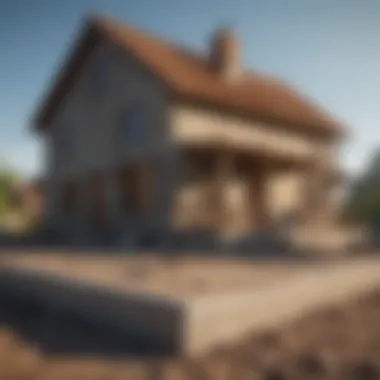How to Determine the Year Your House Was Built


Intro
Understanding when your house was built is not just about knowing its age. It carries implications for property value, renovations, and even historical significance. Many people, especially homeowners, find themselves curious about the origins of their residence. However, determining the exact year of construction can present challenges. This article aims to provide a practical approach to uncovering the construction year of your house. We will explore various methods, resources, and the underlying significance of this knowledge.
Overview of Resources for Determining Your House's Construction Year
Primary Sources of Information
When tackling the question of your home’s age, the first step is to explore primary sources of information. These are the most direct channels to uncover the construction details. Owners can start with:
- Property Deeds: These documents usually indicate when the land was purchased, which can approximate the building date.
- Building Permits: Local government offices keep records of permits issued for construction, renovations, and demolitions.
- Tax Records: Many municipalities maintain archives that detail property assessments, which often include the year built.
Secondary Sources of Information
In addition to primary sources, secondary sources can provide valuable context and details:
- Historical Societies: Local organizations often have records or archives that can shed light on the history of properties.
- Neighborhood Histories: Books or publications focused on your area may contain timelines or historical notes regarding residential development.
- Online Databases: Websites like Wikipedia and Britannica provide information that may remind readers of building trends during certain eras.
Evaluating the Significance
Understanding the age of your house brings multiple benefits. It allows homeowners to evaluate architecture styles, renovation needs, and potential maintenance challenges. Additionally, knowing your home’s age can enrich its story, making it more meaningful.
Knowing your property’s history can often reveal stories about changes in construction methods and local cultural shifts.
While different methods to find construction dates have varying degrees of reliability, applying a combination of approaches can provide clearer insights.
Synthesizing Information for Clarity
After collecting information, homeowners should synthesize what they find. The goal is to establish a reliable estimate of the construction year. This involves comparing different sources and identifying common dates among them. For any discrepancies, consider the reasons behind them. For example, renovations may have taken place or records could be incomplete.
In this guide, we aim to shed light on the process of determining the age of your house. By discussing methods and resources, readers will be empowered to explore their property’s past with confidence.
Prologue
Understanding the age of your house is more than a mere curiosity; it carries substantial implications for homeowners. Knowing when a home was built aids in assessing its historical significance, architectural style, and even its market value. In today's real estate landscape, these factors influence both investment decisions and renovation choices.
Importance of Knowing Your Home's Age
Many individuals may find themselves asking why the year their house was constructed matters. Primarily, knowing your home's age informs matters related to renovations and maintenance. Older homes might require different standards for repair and restoration compared to newer constructions.
Determining the construction year also has implications on historical significance. Homes that belong to particular architectural movements or themes can possess inherent value that is appealing to buyers and historians alike. Investing in a property with a rich history can mean more than just ownership; it can be a link to the past and an opportunity to preserve it.
Additionally, insurance and financing options often vary depending on a home's age. Insurers may require deeper evaluations for older homes, impacting premiums and coverage options. Understanding these aspects can assist homeowners in making informed choices about their property.
Primary Resources for Determining Construction Year


Determining the year a house was built involves various resources that can supply reliable information. Understanding the primary resources is crucial. These sources not only provide details about the construction date but can also reveal historical context about the property and its location.
Property Deeds and Title Searches
Property deeds are legal documents that outline the transfer of ownership. They typically include the date of construction when the property was last conveyed. Conducting a title search can provide insight into how often and when the property has changed hands. Often, the original deed may indicate when it was first built, particularly in older neighborhoods.
To locate property deeds, homeowners can visit local government offices or use online tools in some regions. Knowing your property's relevant history can add value to your understanding of its age and significance.
Building Permits
Building permits are essential records that indicate when a specific structure was legally authorized. They often list the date of issue, which can directly correlate with the year the house was constructed. Local municipalities keep these records, and accessing them can reveal updates or renovations that have taken place over the years. If significant architectural changes were made, those permit records may also show dates related to those alterations.
This approach is particularly beneficial for homes that have undergone substantial renovations, as building permits can provide a clearer picture of a home's developmental timeline.
Local Property Records
Local property records are repositories of information about homes within a municipality. These records include assessments that typically list the year of construction. Many municipalities offer online databases for the public to access this data. Homeowners can also request records at their local tax office or city hall. Accessing these records is often straightforward, making them an invaluable resource in the quest to determine a home's age.
In addition to the year built, local property records might also detail other essential aspects, such as prior ownership and property taxes, which can contribute to a comprehensive understanding of the house's history.
County Assessor's Office
The County Assessor's Office is another reliable source. They maintain property information databases which frequently include the year of construction. This office plays a critical role in assessing property values for taxation based on various factors, including age.
By reaching out to the County Assessor, homeowners can retrieve records related to their property and find out detailed history, not just about construction but also valuation trends over time. This can help potential buyers or current homeowners understand more about the property’s worth in the context of its age and condition.
In summary, locating your home's construction year is attainable with diligent research in primary resources such as property deeds, building permits, local property records, and the County Assessor's Office. Each of these avenues provides unique insights that contribute to a fuller understanding of your home.
Secondary Resources for Finding Historical Information
Determining the construction year of your house can be quite intricate. While primary resources like property deeds and building permits are often the starting point, secondary resources also play a crucial role. These resources can provide context, additional details, and sometimes even lead to surprising discovery. Secondary sources may include historical societies, online databases, and local libraries. Exploring these can enrich your understanding of your home’s history.
Historical Societies and Archives
Historical societies and their archives serve as invaluable repositories of local history. Many communities have dedicated organizations focused on preserving records that reflect their heritage. Visiting these societies can yield estate records, old photographs, and maps detailing the development of a neighborhood over time.
These documents can help paint a picture of your house's past, clarifying key aspects such as initial ownership and changes in architectural style. Each society may vary in the resources available, so it is essential to check multiple local societies, if applicable. Not only can you gain insights, but you may also uncover stories tied to the previous residents of your home.
Online Databases and Tools
In the digital age, online databases have become crucial resources. Websites like Zillow or Redfin offer property histories, including sale dates and sometimes construction years. Other platforms, such as Ancestry.com, may hold historical documents that directly relate to your property's past.
An increasing number of municipalities have digitized their records, making it easier to search your home’s historical data from the comfort of your own home. Using keywords such as "property records" or "house history" along with your address can help in pinpointing useful data. This method is particularly advantageous for those unable to visit physical archives. Always double-check the accuracy of information obtained through these platforms.


Local Libraries
Local libraries possess archives that often go underutilized in the quest to establish a home's age. Many libraries house local history sections with books, articles, and newspapers that document significant events within the community. You could find references to your house in local newspapers or mention of substantial renovations or historical events involving past owners.
Moreover, libraries frequently have staff members who are well-versed in local history and may assist in your search. Engaging with librarians can often lead you toward unexpected resources. Additionally, libraries may sometimes hold workshops and programs focused on genealogy and property research, offering additional tools for in-depth investigations.
"Connecting with history requires persistence, but the insights gained can be rewarding."
Architectural Features and Construction Styles
Understanding the architectural features and construction styles of a house is fundamental to determining its age. This knowledge not only enriches one's appreciation of the home but also provides essential context about the era when it was built. Architectural styles often reflect specific historical, cultural, and technological trends. Identifying these features can aid in dating the house accurately, thereby enhancing overall ownership experience and investment decisions.
Identifying Architectural Styles
Architectural styles serve as a visual language that conveys the historical period during which a house was constructed. Common styles include Victorian, Colonial, Craftsman, and Mid-Century Modern, among others. Each style has unique characteristics that can help pinpoint the era of a home's construction.
For example, Victorian homes often feature intricate trim, asymmetrical facades, and vibrant color palettes. In contrast, Craftsman houses typically have low-pitched roofs, exposed rafters, and built-in furniture. By closely examining these style indicators, homeowners can develop a clearer understanding of their property's history.
Moreover, online resources and local historical societies can provide detailed insights into specific architectural features. Comparing a home’s features to established architectural guidelines can significantly narrow down the construction year. Assessing these styles fulfills both an analytical and historical purpose, allowing owners to appreciate their property even more.
Dating Homes by Design Elements
Design elements within a home can also provide clues to its age. Several factors—such as layout, materials, and decorative motifs—play a crucial role. For instance, the use of particular building materials like asbestos shingles or aluminum siding can suggest certain time periods. Similarly, specific floor plans, like open concept designs or formal living spaces, can indicate when a house was built or renovated.
In addition, stylistic details, such as moldings, windows, and door styles, serve as essential dating markers. The so-called
Consulting Professionals
Home Inspectors
Home inspectors offer detailed evaluations of a property's structure and systems. While their primary role is to assess safety and functionality, their expertise also extends to identifying age-related characteristics. An inspector can recognize materials that were common in specific eras. For example, certain types of roofing shingles or window styles may point towards the decade in which the house was constructed.
An inspector can also draw attention to renovations. Renovated homes can present a blend of older and newer elements. Hence, knowing which aspects are original helps in pinpointing the construction year. This immediate feedback is invaluable during initial assessments.
Real Estate Agents
Real estate agents are another valuable resource. Their depth of knowledge about local markets often includes historical context about homes in the area. They can access listings that may indicate the date of construction. Additionally, real estate agents are well-versed in the nuances of property history. They can provide data on surrounding homes, showing patterns in architecture or development trends that are linked to specific timelines.
Using an agent can also facilitate communication with previous owners. They might have valuable anecdotes or documents regarding the property’s past. Therefore, if assistance in determining a home’s age is necessary, enlisting a knowledgeable agent can be an efficient strategy.
Historians and Preservationists
Historians and preservationists focus on the broader cultural significance of buildings. They may be affiliated with local historical societies, sharing resources that offer insights into a home's past. Their understanding of architectural styles and historical significance ensures that property owners have a complete picture of their home’s historical context.


If a house is part of a historical district, preservationists will provide guidelines that can keep the property aligned with local heritage. They can help in navigating any legalities surrounding renovations and restorations.
In summary, consulting professionals offers multiple benefits when trying to determine your home's construction year. Their combined expertise can save time and provide accurate information, which contributes to a deeper understanding of your property’s past.
Understanding the Implications of Your Home's Age
Knowing the age of your home is not merely an academic exercise. The information impacts various aspects of homeownership, from financial considerations to the home's future. Understanding how the age of your house influences its value, insurances, loans, and renovation plans can be crucial. It prepares you for potential challenges while also unveiling opportunities that accompany living in an older structure.
Historical Value and Appreciation
The historical significance of a house contributes substantially to its value. Houses that are older often have unique architectural styles that reflect the times in which they were built. This distinctiveness can appeal to buyers or investors interested in historical properties.
- Investment Perspective: An older home can gain value over time, particularly in areas where preservation efforts are strong.
- Cultural Significance: Homes that have historical relevance can attract buyers who value heritage. Such homes often serve as symbols of local history, which can make them more desirable.
- Market Trends: Historically recognized homes tend to appreciate better than newer constructions, especially if they are well-maintained. Investors often seek these properties, impacting their resale value.
The appraisal process takes the age into account as well. A home’s age can offer insights into its potential appreciation or depreciation in the market.
Impacts on Insurance and Loan Choices
The age of your home significantly influences insurance policies and mortgage loans. These factors are critical for homeowners, as they affect financial commitments.
- Insurance Costs: Older homes may require special insurance considerations. Insurers might charge higher premiums since older homes could have outdated electrical, plumbing, or structural systems. Understanding this can help you budget better for insurance expenses.
- Loan Requirements: Lenders can have stricter requirements for financing older homes. They may wish to see inspections that ascertain the property’s condition. A house with an outdated structure might limit your financing options.
- Renovation Loan Programs: Some lending institutions offer programs tailored for older homes, allowing you to borrow additional funds for renovation. Familiarity with these can open doors for improvements that maintain or even enhance value.
It's imperative to understand these implications before purchasing or refinancing, as well-informed decisions can lead to better financial outcomes.
Renovation Considerations
Renovating an older home brings both challenges and advantages. Knowing the age of your house helps frame renovation efforts, ensuring that you respect its original character while updating facilities.
- Preservation vs. Modernization: Homeowners may struggle between modern updates and preserving original features. Understanding the home's era can guide appropriate choices for materials and design.
- Structural Integrity: Older homes might require more extensive repairs during renovations. Recognizing the build year allows you to anticipate potential structural challenges.
- Incentives for Renovation: Some local or federal programs offer incentives for maintaining the historical integrity of older homes. Investigating applicable grants or tax breaks based on your home's age might yield helpful benefits.
The clarity about your home’s age will guide planning. Adequate renovations not only enhance livability but can sustain or increase value over time.
Overall, understanding the implications of your home's age equips you with the necessary knowledge to navigate challenges and identify opportunities. By considering factors like historical value, insurance impacts, and renovation challenges, you position yourself for informed decision-making that aligns with your homeownership goals.
Ending
Understanding when your house was built is more than just a curiosity. It informs homeowners about the historical and architectural significance of their property. This knowledge can influence maintenance decisions, renovation styles, and even property value assessments.
Recap of Methods Explored
This article detailed several methods for determining the construction year of your house. We discussed the following resources:
- Property Deeds and Title Searches: These legal documents trace ownership and can provide clues about construction dates.
- Building Permits: Checking local authorities for building permits can reveal the year the house was completed.
- Local Property Records: Municipal or county property records can hold valuable information on the building’s history.
- County Assessor's Office: This office typically keeps track of property ages and updates.
- Historical Societies and Archives: These entities often have records that can put your home in a historical context.
- Online Databases and Tools: Various websites compile data that might include the year of construction.
- Local Libraries: Archives in libraries can also provide historical data on your neighborhood.
- Home Inspectors, Real Estate Agents, Historians, and Preservationists: These professionals can offer insights based on their expertise, helping to further pinpoint your home's age.
By using a combination of these approaches, homeowners can gather a more comprehensive picture of their property's age and background.
Encouragement for Further Research
As you dig into your home's past, continue to explore the myriad of sources available. The blend of personal stories, structural details, and historical context enriches your appreciation of your living space. Local archives, historical societies, and even online forums like Reddit can be great places to find more information and connect with others who share similar interests. Valuable insights can also come from engaging with professionals who help you better understand the specifics of your home. This journey not only enhances your knowledge of your property but also fosters a deeper connection to your community and its history.



